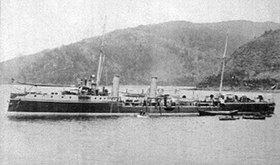Almirante Lynch (1890)
|
|
|
|---|---|
 The Almirante Lynch |
|
| Overview | |
| Type | Torpedo gunboat |
| Shipyard | |
| Keel laying | 1889 |
| Launch | 1890 |
| Namesake | Rear Admiral Patricio Lynch |
| Commissioning | . January 1891 |
| Technical specifications | |
| displacement |
700 ts |
| length |
70.0 m waterline, |
| width |
8.0 m |
| Draft |
6.0 m |
| crew |
87 men |
| drive |
4 cylinder boilers |
| speed |
20.2 kn |
| Range |
2500 nm at 10 kn |
| Armament |
• 6 × 6-pounder cannons |
| renamed |
Tomás |
| cancellation |
June 26, 1919 |
| Sister ship |
Almirante Condell |
| similar |
13 British boats |
The Chilean torpedo cannon boat Almirante Lynch sank the armored frigate Blanco Encalada , the flagship of the rebels, with a torpedo during the Chilean civil war on April 22, 1891 . It was the first sinking of a warship by a self-propelled torpedo.
Building history
The Almirante Lynch and her sister boat, the Almirante Condell, were torpedo cannon boats ordered by the Chilean Navy from the Laird Brothers shipyard in Birkenhead , Great Britain, in 1889 . In size and performance, they were similar to the Sharpshooter class boats that the Royal Navy had procured at the same time , but from which they differed externally and from which the shipyard did not build any. The steel boats built for Chile had a high poop and smokestacks that were closer together, while those of the "Royal Navy" boats were extremely far apart.
The displacement of the Almirante Lynch was 700 ts and she could reach over 20 knots. This made the two Chilean boats a little faster than the British units. The two boats were armed with five 358 mm surface torpedo tubes of the Whitehead type , one of which was set up in the bow and two in each side. Then there were initially six of Elswick built under license 57 mm - Hotchkiss -Geschütze and two machine guns of the type Gatling .
Later, both boats received three 76 mm Maxim Nordenfelt guns for the Hotchkiss 6 pounders , two of which stood one behind the other on the foredeck and one on the poop.
The namesake of the boat, Rear Admiral Patricio Javier de los Dolores Lynch y Solo de Zaldívar (1825-1886) was a Chilean naval officer and Commander-in-Chief of the Navy at the end of the Saltpetre War (Spanish Guerra del Pacífico ) against Peru and Bolivia and from 1881 to 1884 head of the Administration of the occupied parts of Peru. The namesake of the second boat was the rear admiral Carlos Arnaldo Condell De La Haza (1843–1887), who died early and had distinguished himself as a ship commander several times.
Mission history
On January 6, 1891, the leaders of the president boarded José Manuel Balmaceda dissolved Congress in Valparaíso , the armored frigate Blanco Encalada and left on January 7 with the Blanco Encalada and the Esmeralda , the corvette O'Higgins and other ships Valparaiso northwards to Tarapaca to organize military resistance against the President. The armored frigate Almirante Cochrane towed the Huáscar , whose machines were not operational, from Valparaiso south to Las Salinas near Talcahuano , where the tower ship was made operational.
The only significant naval units on the President's side were the Almirante Lynch and Almirante Condell, who arrived in Chile from Great Britain in January and February 1891, respectively . On April 22, 1891, they attacked the flagship of the Congress Navy Blanco Encalada in the bay in front of the Caldera . Of the Almirante Lynch's six torpedoes , one hit the battleship, which sank in less than ten minutes, killing 182 sailors. This was the first sinking of a larger warship with a self-propelled torpedo. The commander of the Congress Fleet and later President of Chile, Jorge Montt , was not on board.
There were no other significant operations by the President's naval forces. The hope of receiving cruisers commissioned in France failed due to the French government's position of neutrality.
In 1900 the two torpedo cannon boats were thoroughly overhauled. In September 1907 the government was authorized to sell this and the newer destroyer Almirante Simpson (1895, 800 ts, 21 kn) to a friendly nation. There was no interested party in the gunboats. Only the Simpson was sold to Ecuador , where it was named Libertador Simón Bolívar . The two old torpedo cannon boats were overhauled again in 1909 and now had Belleville shells . In endurance tests, both boats ran faster than 20 knots for more than eight hours.
From 1913 the delivery of the new 1430 ts destroyers of the Almirante Lynch class from White, which were named Almirante Lynch and Almirante Condell . The old Almirante Lynch and Almirante Condell remained as Tomás and Talcahuano until they were demolished in 1919 .
literature
- John Roberts, HC Timewell, Roger Chesneau (Ed.), Eugene M. Kolesnik (Ed.): Warships of the World 1860 to 1905 - Volume 2: USA, Japan and Russia . Bernard & Graefe Verlag, Koblenz, 1983, ISBN 3-7637-5403-2 .
- Edwyn Gray: The Devil's device: the story of Robert Whitehead, inventor of the torpedo . Naval Institute Press, Annapolis 1991, 310 pages, ISBN 0-8702-1245-1 .
Web links
- Torpedo gunboat Almirante Lynch (I) ( memento from October 19, 2013 in the Internet Archive ) on the side of the Chilean armed forces
- Torpedo cannon boat Almirante Condell (I) ( memento from October 19, 2013 in the Internet Archive ) on the side of the Chilean armed forces

